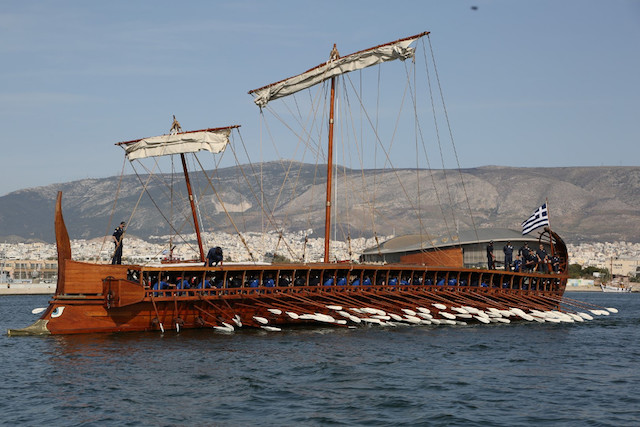 The
trireme during the test sail and arrival at Museum of Naval History in
Athens. The
trireme during the test sail and arrival at Museum of Naval History in
Athens.(Photos: Hellenic Navy) |
|||
The repair
and maintenance work took place at the Hellenic Navy’s largest base
in Salamis Island by the fleet’s engineers and technicians. Trireme
Olympias was first launched in May 1985 and handed over to the navy in
July 1987. It has a length of 36.9m, beam of 5.5m, draft of 1.25m and
35t of displacement. Hellenic Navy’s Athenian Trireme is a true copy of the formidable vessels of the antiquity. These vessels proved their capabilities during the epic Battle of Salamis in 29 September 480 BC, considered as one of the biggest battles in world history. Their name Trireme or Triiris in Greek means three rows of paddles-rowers. They were designed to be manoeuvrable and assume missions as the antiquity’s littoral combat ships. Their maximum speed was eight knots which could rise to 10 knots with the use of sails in good wind conditions. Their crew consisted of 170-200 men, all of them free citizens, as no slaves or convicts were allowed to man the vessels. Pine wood was used in their construction, in order to keep the weight as low as possible. Their main weapon was a 200 kg and two metres long wooden ram covered with metal. In addition to that, each vessel had a small detachment of soldiers and archers, while the rowers were armed in case they also had to attack a ship with close combat. Most importantly, their design allowed for the trireme to be destroyed by an enemy vessel but without being sunk. This explains why there are almost no trireme shipwrecks. Thanks to these characteristics and the manoeuvrability, the Athenian-led Hellenic fleet managed to defeat the Persian fleet at the battle of Salamis. During its first years, the modern trireme was used in experimental archaeology sails, in an effort to define the design’s characteristics and durability, the living conditions of the crew-rowers and understand the tactics used in the antiquity. Since then, Olympias took part, among others, in the 1993 celebrations in London for the 2,500 since the birth of Democracy in Greece and to transport the Olympic Flame at the beginning of the Athens 2004 Olympic Games. The Hellenic Navy aiming at safeguarding and promoting the country’s naval tradition, while having an open policy towards the society, will organize in the near future, sails of the trireme, with crews consisting of citizens who will volunteer to row in order to come closer with history. |
|||
Hellenic Navy launched ancient trireme Olympias back to sea
- Posted On










